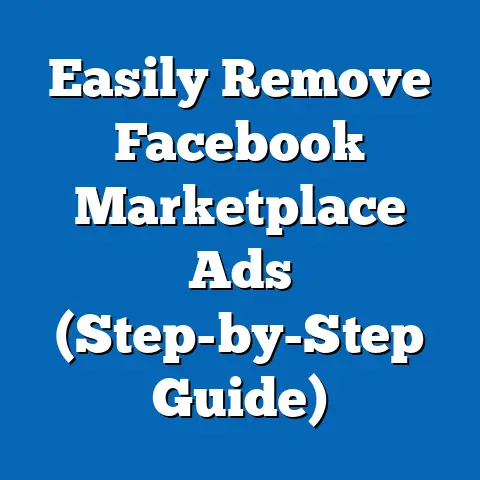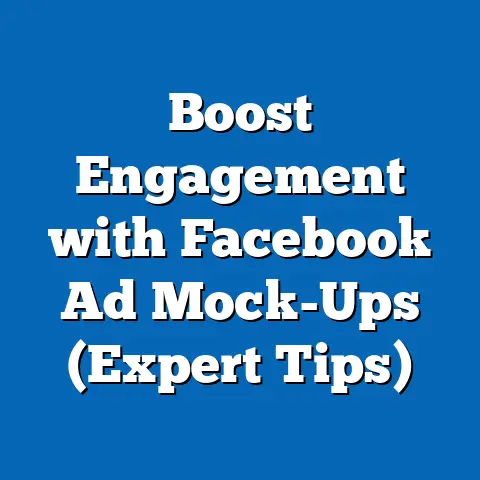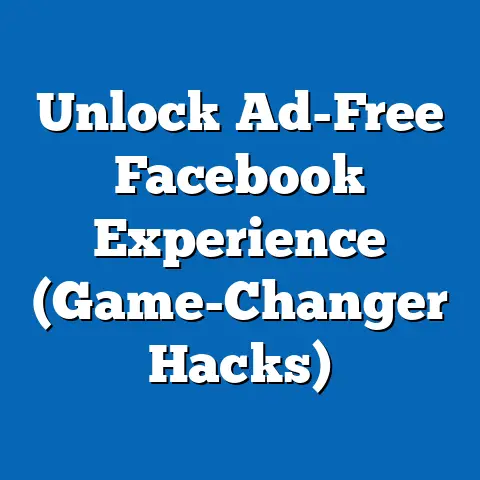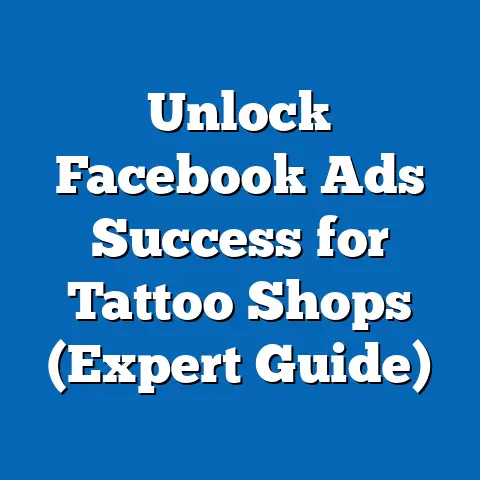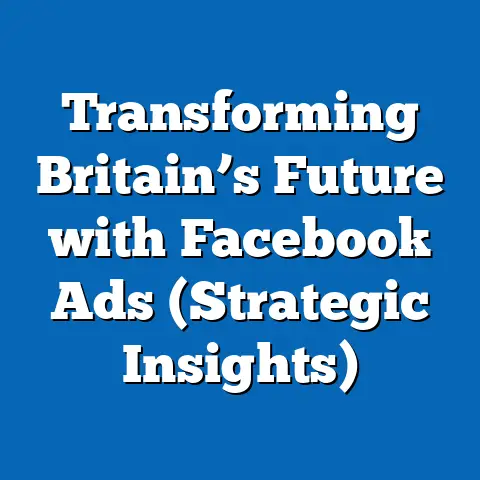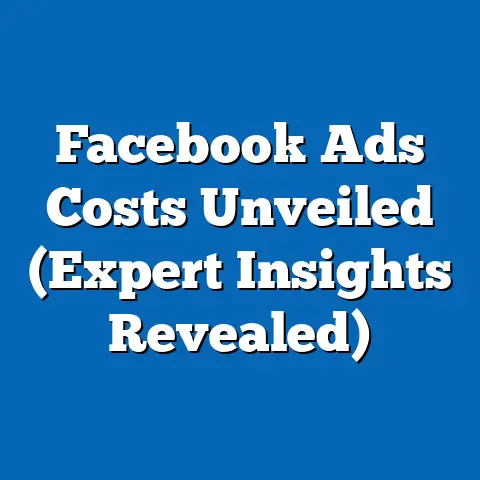Master Campaigns, Ads & fb ad Sets (Unlock Ultimate Strategy)
In today’s digital age, Facebook advertising has become an indispensable tool for businesses of all sizes. It’s not just about throwing money at ads and hoping for the best; it’s about crafting a strategic approach that leverages the platform’s powerful targeting capabilities and creative options. When campaigns, ads, and ad sets are meticulously optimized, the potential for increased reach, enhanced engagement, and improved conversion rates is truly remarkable.
I’ve personally witnessed the transformation that a well-executed Facebook advertising strategy can bring. I remember working with a small local bakery that was struggling to attract new customers. By implementing a targeted Facebook campaign, crafting visually appealing ads, and carefully segmenting their audience, we saw a 40% increase in foot traffic within just a few months. That’s the power of understanding and mastering the Facebook advertising ecosystem.
Understanding the Facebook Advertising Ecosystem
The Facebook advertising framework is built on a hierarchical structure consisting of three key components: campaigns, ad sets, and ads. Think of it like a pyramid, with the campaign forming the foundation, the ad sets acting as the supporting structure, and the individual ads representing the visible peak. Each component plays a crucial role in the overall success of your advertising efforts.
- Campaigns: At the highest level, the campaign sets the overall objective for your advertising efforts. This could be anything from increasing brand awareness to generating leads or driving conversions. The campaign objective dictates the type of ads you’ll run and the metrics you’ll track.
- Ad Sets: Ad sets sit beneath the campaign level and define the specific audience you’re targeting, the budget you’re allocating, and the schedule you’re running your ads on. They allow you to segment your audience and tailor your messaging to different groups.
- Ads: At the bottom of the pyramid are the individual ads themselves. These are the creative assets that your target audience will see, including the visuals, copy, and call-to-action.
The interaction between these three components is crucial. A well-defined campaign objective guides the creation of targeted ad sets, which in turn deliver relevant ads to the right audience. This alignment ensures that your advertising efforts are focused, efficient, and effective.
Takeaway: Understanding the hierarchical structure of Facebook advertising is essential for creating a successful strategy. Each component plays a vital role, and aligning them with your business objectives and target audience is paramount.
Crafting Effective Campaigns
The campaign level is where you define the overarching goal of your advertising efforts. Are you trying to increase brand awareness, generate leads, drive website traffic, or boost sales? Choosing the right campaign objective is the first step towards achieving your desired results.
Setting Clear Goals and Objectives
Before you even log into Facebook Ads Manager, take a step back and define what you want to achieve with your advertising. Are you launching a new product? Promoting a special offer? Building your email list? Your campaign objective should be specific, measurable, achievable, relevant, and time-bound (SMART).
Here are some common Facebook campaign objectives:
- Awareness: Reach, Brand Awareness
- Consideration: Traffic, Engagement, App Installs, Video Views, Lead Generation, Messages
- Conversion: Conversions, Catalog Sales, Store Traffic
Choosing the Right Campaign Objective
Selecting the appropriate campaign objective is crucial because it influences how Facebook optimizes your ads. For example, if you choose the “Conversions” objective, Facebook will prioritize showing your ads to people who are most likely to take a desired action, such as making a purchase or filling out a form.
Here’s how to choose the right objective based on your business goals:
- Brand Awareness: If your goal is to increase brand recognition and reach a wider audience, choose the “Reach” or “Brand Awareness” objective.
- Lead Generation: If you want to collect leads for your sales team, choose the “Lead Generation” objective.
- Website Traffic: If your goal is to drive traffic to your website, choose the “Traffic” objective.
- Sales: If you want to increase online sales, choose the “Conversions” or “Catalog Sales” objective.
Budgeting Strategies
Budgeting is another critical aspect of campaign management. Facebook offers two main budgeting options:
- Daily Budget: This sets a fixed amount that Facebook will spend on your ads each day.
- Lifetime Budget: This sets a total amount that Facebook will spend on your ads over the entire duration of the campaign.
I often recommend starting with a daily budget, especially when you’re testing different ad sets and creatives. This allows you to control your spending and make adjustments as needed. Once you’ve identified what works best, you can switch to a lifetime budget for more predictable spending.
Understanding Cost-Per-Action (CPA)
CPA is a key metric that measures the cost of acquiring a specific action, such as a lead or a sale. Understanding your CPA is crucial for determining the profitability of your campaigns. To calculate your CPA, simply divide your total ad spend by the number of desired actions you’ve achieved.
Real-World Examples
Let’s look at a couple of real-world examples of successful Facebook ad campaigns:
- Dollar Shave Club: This company used humorous video ads to raise brand awareness and drive subscriptions. Their campaign was highly successful because it was engaging, relatable, and targeted to a specific audience.
- Airbnb: This company uses visually appealing ads to showcase unique travel experiences. Their campaign is effective because it taps into people’s desire for adventure and provides a compelling reason to book through Airbnb.
Takeaway: Crafting effective campaigns requires setting clear goals, choosing the right objective, implementing smart budgeting strategies, and understanding your CPA. By learning from successful examples and continuously optimizing your campaigns, you can achieve significant results.
Designing High-Impact Ads
Your ads are the face of your brand on Facebook, so it’s essential to make a strong impression. A high-impact ad is visually appealing, clearly communicates your message, and compels the viewer to take action.
Key Elements of an Effective Ad
Here are the key elements that contribute to an effective Facebook ad:
- Visuals: Use high-quality images or videos that are relevant to your target audience and your offer.
- Copy: Write concise and compelling copy that highlights the benefits of your product or service.
- Call-to-Action (CTA): Include a clear and direct CTA that tells viewers what you want them to do (e.g., “Shop Now,” “Learn More,” “Sign Up”).
- Audience Targeting: Ensure that your ad is shown to the right people by using Facebook’s targeting options.
A/B Testing for Ad Creative and Messaging
A/B testing, also known as split testing, is a crucial process for optimizing your ad creative and messaging. It involves creating two or more versions of an ad with slight variations and then testing them against each other to see which performs better.
For example, you could test different headlines, images, or CTAs to see which combination results in the highest click-through rate or conversion rate. A/B testing allows you to make data-driven decisions and continuously improve your ad performance.
Eye-Catching Visuals and Compelling Copy
Your visuals are the first thing that people will notice about your ad, so it’s crucial to make them eye-catching. Use high-quality images or videos that are visually appealing and relevant to your target audience.
Your copy should be concise, compelling, and highlight the benefits of your product or service. Focus on solving a problem for your target audience and explain how your product or service can help them achieve their goals.
Utilizing Facebook’s Ad Formats
Facebook offers a variety of ad formats to choose from, each with its own strengths and weaknesses:
- Image Ads: These are simple ads that feature a single image and some text. They’re a great option for showcasing a product or service in a visually appealing way.
- Video Ads: These ads feature a short video that can be used to tell a story, demonstrate a product, or provide valuable information.
- Carousel Ads: These ads allow you to showcase multiple images or videos in a single ad unit. They’re a great option for showcasing a range of products or features.
- Slideshow Ads: These ads are similar to video ads but use a series of images instead of a video. They’re a great option for creating engaging content without requiring a lot of bandwidth.
Takeaway: Designing high-impact ads requires a combination of eye-catching visuals, compelling copy, and a clear call-to-action. A/B testing is essential for optimizing your ad creative and messaging, and utilizing Facebook’s ad formats can help you maximize engagement.
Optimizing Ad Sets for Success
Ad sets are the engine that drives your Facebook advertising campaigns. They allow you to target specific audiences with tailored messaging, ensuring that your ads are seen by the right people at the right time.
What Are Ad Sets?
Ad sets are the middle level of the Facebook advertising hierarchy, sitting between campaigns and ads. They define the specific audience you’re targeting, the budget you’re allocating, and the schedule you’re running your ads on.
Audience Segmentation
Audience segmentation is the process of dividing your target audience into smaller groups based on shared characteristics, such as demographics, interests, behaviors, and location. This allows you to tailor your messaging to each segment, increasing the relevance and effectiveness of your ads.
Using the Facebook Audience Insights Tool
The Facebook Audience Insights tool is a powerful resource for understanding your target audience. It provides valuable data on demographics, interests, behaviors, and more. You can use this data to create highly targeted ad sets that reach the right people.
Strategies for Setting Up Effective Ad Sets
Here are some strategies for setting up effective ad sets:
- Demographic Targeting: Target your audience based on age, gender, education, and other demographic factors.
- Interest Targeting: Target your audience based on their interests, hobbies, and passions.
- Behavior Targeting: Target your audience based on their online behavior, such as their purchase history and the websites they visit.
- Lookalike Audiences: Create lookalike audiences based on your existing customers or website visitors. These audiences are made up of people who share similar characteristics to your best customers.
Monitoring and Adjusting Ad Sets
Once you’ve set up your ad sets, it’s essential to monitor their performance and make adjustments as needed. Track key metrics such as click-through rate, conversion rate, and cost-per-click. If an ad set is underperforming, try adjusting the targeting, budget, or creative.
Takeaway: Optimizing ad sets is crucial for reaching the right audience with the right message. Audience segmentation, the Facebook Audience Insights tool, and strategic targeting options can help you create highly effective ad sets. Monitoring and adjusting your ad sets based on performance analytics is essential for continuous improvement.
Analyzing and Adjusting Your Strategy
Data is the lifeblood of successful Facebook advertising. By tracking key performance indicators (KPIs) and analyzing the data, you can gain valuable insights into what’s working and what’s not. This allows you to make informed decisions and optimize your campaigns for maximum ROI.
Key Performance Indicators (KPIs)
Here are some key performance indicators to track for your campaigns, ads, and ad sets:
- Click-Through Rate (CTR): This measures the percentage of people who click on your ad after seeing it. A high CTR indicates that your ad is relevant and engaging.
- Conversion Rate: This measures the percentage of people who take a desired action after clicking on your ad, such as making a purchase or filling out a form. A high conversion rate indicates that your ad is effective at driving results.
- Cost-Per-Click (CPC): This measures the cost of each click on your ad. A low CPC indicates that your ad is efficient at driving traffic.
- Cost-Per-Action (CPA): As mentioned earlier, this measures the cost of acquiring a specific action, such as a lead or a sale.
- Return on Ad Spend (ROAS): This measures the revenue generated for every dollar spent on advertising.
Utilizing Facebook Ads Manager
Facebook Ads Manager is your central hub for data analysis and reporting. It provides a wealth of information on your campaign performance, including metrics, demographics, and audience insights.
Interpreting Data and Making Informed Decisions
Analyzing the data in Facebook Ads Manager can be overwhelming, but it’s essential for making informed decisions. Look for trends and patterns in your data to identify what’s working and what’s not.
For example, if you notice that a particular ad set has a high CTR but a low conversion rate, it could indicate that your ad is engaging but your landing page is not optimized for conversions. In this case, you would need to focus on improving your landing page to increase your conversion rate.
Takeaway: Analyzing your data and making informed decisions is crucial for optimizing your Facebook advertising campaigns. By tracking key performance indicators, utilizing Facebook Ads Manager, and interpreting your data effectively, you can continuously improve your results.
Conclusion
Mastering Facebook advertising is an ongoing process that requires continuous learning and adaptation. By understanding the fundamentals of campaigns, ads, and ad sets, and by implementing the strategies discussed in this guide, you can unlock your ultimate advertising potential and achieve your business goals.
Remember that Facebook’s advertising landscape is constantly evolving, so it’s essential to stay up-to-date with the latest features and best practices. Experiment with different ad formats, targeting options, and messaging strategies to find what works best for your business.
I hope this guide has provided you with the knowledge and tools you need to succeed with Facebook advertising. Now it’s time to put these strategies into action and start seeing results.
Call to Action:
I’d love to hear about your experiences with Facebook advertising. Share your thoughts and questions in the comments below. And be sure to subscribe for more insights on digital marketing strategies!

